When you think about your cafe menu, it’s more than just a list of items; it’s a powerful tool for engaging customers. By optimizing how you present your offerings, you can significantly improve their dining experience and influence their choices. You might wonder how strategic design, appealing visuals, and customer feedback can transform a menu from mundane to memorable. It’s not just about aesthetics; it’s about creating connections that keep people coming back. What if you could unlock hidden potential in your menu that drives not just sales, but furthermore loyalty?
Understanding Customer Interaction
Understanding customer interaction is crucial for any cafe looking to thrive in a competitive market. You need to recognize how menu psychology influences customer preferences and decision-making. When customers walk into your cafe, their eyes naturally gravitate toward certain items based on their layout and presentation. This is where you can utilize menu psychology to steer their choices.
Consider how you present your offerings. Highlighting popular items or using descriptive language can create a sense of urgency and desirability. By understanding customer preferences, you can tailor your menu to feature items that resonate with your target audience. For instance, if you notice that seasonal flavors attract more customers, make sure those items stand out.
Moreover, think about the emotional connection your menu cultivates. Are you invoking nostalgia with classic recipes or appealing to health-conscious consumers through fresh, wholesome options? The way you structure your menu can significantly impact interactions, encouraging customers to engage more deeply with what you offer.
Ultimately, by mastering customer interaction through menu psychology, you’ll not only improve the dining experience but also boost sales and customer loyalty.
Importance of Menu Design
Menu design plays a pivotal role in shaping the overall customer experience at your cafe. It’s not just about listing items; it’s about creating an inviting atmosphere that encourages customers to engage with your offerings.
Effective menu aesthetics can draw attention and guide customers through their choices, making them feel more connected to what you serve. When you incorporate appealing visuals and a unified layout, you improve the likelihood that customers will linger over the menu and investigate their options.
Clear and enticing flavor descriptions can spark curiosity and entice customers to try something new. Instead of just stating ingredients, consider painting a picture of the taste experience. For example, instead of saying “chocolate cake,” you might describe it as “decadent, rich chocolate cake drizzled with velvety ganache.”
This approach not only highlights the quality of your offerings but additionally engages the customer’s senses. Well-designed menus can evoke emotions and create memories associated with your cafe.
Ultimately, thoughtful menu design can significantly impact customer satisfaction, loyalty, and even your cafe’s bottom line.
Elements of Engaging Menus
An engaging menu captures customers’ attention and invites them to investigate your offerings. To create this connection, focus on these key elements:
- Menu Language: Use descriptive and enticing language that paints a picture of each dish. Instead of just listing “chocolate cake,” try “rich, velvety chocolate cake topped with a silky ganache.” This sparks curiosity and makes customers enthusiastic to try it.
- Item Descriptions: Write clear and concise descriptions that highlight the unique aspects of each item. Include ingredients, preparation methods, or the story behind the dish. This not only informs customers but additionally adds a personal touch that improves their dining experience.
- Emotional Appeal: Connect with your customers by tapping into their emotions. Use words that evoke memories or feelings, like “comforting,” “indulgent,” or “refreshing.” When customers can relate to your offerings on an emotional level, they’re more likely to make a purchase.
Utilizing Visual Appeal
Visual appeal plays a crucial role in engaging customers and improving their dining experience. When you design your cafe menu, consider the power of color psychology. Colors can evoke emotions and influence decisions. For instance, warm colors like red and orange can stimulate appetite, while cool colors like blue can suppress it. Choose hues that align with the ambiance of your cafe and the vibe you want to convey.
Next, focus on layout strategies that guide your customers’ eyes and decisions. A well-organized menu with clear sections makes it easier for patrons to find what they want. Use headings and subheadings to categorize items, helping your customers navigate the menu effortlessly. Highlighting signature dishes or specials using boxes or icons can draw attention to what you want to promote.
Don’t forget to incorporate appealing images. High-quality photos of your food can entice customers and make the menu more visually appealing.
Ultimately, by combining color psychology with effective layout strategies, you’ll create a menu that not only looks great but also improves customer interaction, leading to a more satisfying dining experience.
Leveraging Customer Feedback
Many cafe owners overlook the value of customer feedback, but it can be a game-changer for optimizing your menu. By actively seeking out and leveraging customer opinions, you can fine-tune your offerings to better align with customer preferences.
This approach not only improves the dining experience but likewise boosts sales.
Here are three effective strategies for feedback collection:
- Surveys: After dining, send out quick surveys via email or SMS. Ask customers about their favorite dishes and what they’d like to see more of.
- Comment Cards: Place comment cards on tables for customers to fill out during their visit. This encourages immediate feedback while their experience is fresh in their minds.
- Social Media Engagement: Use your cafe’s social media platforms to ask questions about menu items. You can even run polls to gauge interest in potential new dishes.
Implementing Digital Solutions
Harnessing technology can significantly improve your cafe’s menu optimization efforts. By implementing digital solutions, you can gain valuable insights into customer preferences and behaviors. Utilizing digital tools like menu analytics can help you track which items are most popular and which ones need a refresh.
Start by integrating a digital menu system that allows you to update offerings in real-time. This flexibility lets you experiment with seasonal items and promotions, ensuring your menu stays relevant and engaging.
In addition, consider adopting customer relationship management (CRM) software to collect and analyze feedback more effectively.
With menu analytics, you can examine sales data, identify trends, and even adjust prices based on demand. This data-driven approach helps you make knowledgeable choices that align with your customers’ desires.
Moreover, interactive menus can improve customer engagement, allowing patrons to customize their orders and investigate new options easily.
Conclusion
Optimizing your cafe menu for customer interaction isn’t just about aesthetics; it’s about creating an experience that resonates with your guests. By understanding their preferences and incorporating engaging design elements, you can guide their choices and improve satisfaction. Don’t forget to utilize customer feedback and digital tools for continuous improvement. When you focus on these aspects, you not only drive sales but also cultivate lasting connections with your customers, making your cafe a go-to destination.


